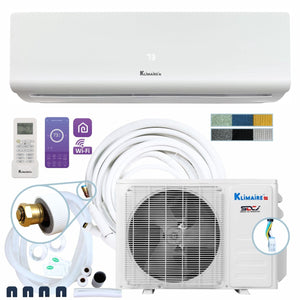Do-It-Yourself Mini Split Systems
 20% OFF
20% OFF
Klimaire DIY 24,000 BTU 19 SEER2 Ductless Mini Split Heat Pump Air Conditioner 4th Generation 25 ft. Pre-charged Installation Kit & Wi-Fi - 230V
$1,684.00
$2,096.00
$1,684.00
$2,096.00
 20% OFF
20% OFF
Klimaire DIY 36,000 BTU 19 SEER2 Ductless Mini Split Heat Pump Air Conditioner with 25 ft Pre-charged Installation Kit & Wi-Fi - 230V
$2,356.00
$2,943.00
$2,356.00
$2,943.00
 12% OFF
12% OFF
Klimaire DIY 18,000 BTU 19 SEER2 Ductless Mini Split Heat Pump Air Conditioner with 25 ft Pre-charged Installation Kit & Wi-Fi - 230V
$1,469.00
$1,675.00
$1,469.00
$1,675.00
 20% OFF
20% OFF
Klimaire DIY 12,000 BTU 19 SEER2 Ductless Mini Split Heat Pump Air Conditioner with 25 ft Pre-charged Installation Kit & Wi-Fi - 230V
$1,098.00
$1,373.00
$1,098.00
$1,373.00
 17% OFF
17% OFF
Klimaire DIY 12,000 BTU 19 SEER2 Ductless Mini Split Heat Pump Air Conditioner with 25 ft Pre-charged Installation Kit & Wi-Fi - 115V
$1,189.00
$1,435.00
$1,189.00
$1,435.00
Features of DIY AC Systems
So your home improvement project is almost done, and you’re eyeing a diy mini split that consists of indoor and outdoor units. While you can tackle a DIY mini split installation yourself, it’s important to know the risks. You may save on labor but you still need a pro to fix any mistakes. Some models truly are an easy install, but many cooling system components, like refrigerant lines and electrical hookups, require solid technical know-how. You’ll need intermediate expertise in wiring, spare parts, and handling the air handler.
That said, DIY mini split systems deliver energy efficiency and multi zone flexibility at great prices. Let’s explore the benefits.
Temperature Control
A DIY mini split’s intuitive thermostat puts temperature control in your hands. Set your ideal set temperature, and the cooling system will cycle off or throttle output once reached. Most units include Auto, Dry, Cool, and Heat modes. High-end models add geofencing, so your air handler kicks on as you near home.
No Expensive Tools for Connecting
Ductless mini split ACs feature pre-charged refrigerant lines and simple brackets, making for an easy install. You won’t need specialized tools or complex duct fittings, which keeps startup costs low.
Easy Mount System
Mounting a mini split is straightforward. Choose the perfect spot for your outdoor unit and indoor air handler, then route lines through a single wall hole. With no bulky central systems, you can customize placements for optimal comfort in multiple rooms.
No Duct Work Needed
Because it’s ductless, a DIY mini split eliminates the expense and complexity of existing ductwork. That saves time, money, and hassle—and boosts energy efficiency by avoiding air leaks. The result: targeted cooling for multiple rooms without the overhead of a full central system.
Comparison of DIY Mini Split Systems & Conventional HVAC
When it comes to putting things side by side for a better contrast between DIY mini splits and traditional HVAC systems, both have some impressive features worth considering. For starters, mini split systems are usually more energy-efficient than central air systems because there is no ductwork involved which wastes a lot of energy. But there’s more to this comparison, so let’s take a closer look at the differences.
No Duct Work
As we mentioned earlier, mini split systems are designed to be installed by people with basic DIY skills and may not always require professional help. They're simple to set up since they come with refrigerant lines that are already pre-charged and only need a small hole in the wall for the lines. However, this is not the case with regular HVAC systems, which are more complex and need a pro’s involvement.
Requires Expensive Ductwork
Since traditional HVAC systems need extensive ductwork and take up more space with large central units, the installation process effort as well as overhead costs shoot up. This does not apply to DIY mini splits as they are more compact and simple overall.
Cost Effective Equipment
Mini split systems may cost more than traditional HVAC models but, in the bigger scheme of things, they save you money. Here’s how: Mini split systems are great for cooling specific rooms or areas, unlike central air, which cools the entire home, thus using up more energy and shooting up costs. These systems also provide heating and do so much more efficiently—up to 3-4 times better than traditional equipment. Also, DIY mini split AC systems are easier to take care of because they have fewer components.
DIY Installation
Finally, the whole point of investing in a ductless mini split is the DIY factor, which allows you to install an energy-efficient, effective, and compact air conditioning system without breaking the bank. The same ease and flexibility is not an option when it comes to conventional HVACs.
Shop DIY Mini Split Systems Online
Ready to install a diy mini split yourself? HeatAndCool.com offers top brands at great prices, with free delivery, expert consultation, and fast shipping. Get the efficient, multi-zone cooling system your home deserves without the markup. Explore our lineup today!
Frequently Asked Questions
What is a DIY mini-split system?
A DIY mini-split system is a type of do it yourself air conditioner that allows homeowners to install a heating and cooling unit without professional assistance. These systems include pre-charged refrigerant lines and user-friendly connections, making installation simple. Unlike traditional systems, DIY mini-splits do not require ductwork, making them energy-efficient and ideal for home additions, garages, and other spaces. DIY ac systems offer flexibility and cost savings, making them a popular choice for homeowners looking for an easy climate control solution.
What makes a DIY mini-split different from a regular mini-split?
The installation process is the biggest difference between DIY mini-split systems and traditional mini-splits. A do it yourself mini-split air conditioner comes with pre-charged refrigerant lines that eliminate the need for specialized tools or professional installation. Regular mini-splits, on the other hand, require an HVAC technician to charge the system and connect refrigerant lines. This makes DIY mini-splits a cost-effective and hassle-free alternative for those who want to install a system on their own.
Do I need special tools to install a DIY mini-split system?
One of the main advantages of DIY ductless mini-split systems is that they do not require special, unique tools for installation. Most do it yourself mini-split systems come with everything needed for setup, including pre-charged line sets and simple connections. A few basic household tools, such as a drill, screwdriver, and wrench, may be needed, but no professional HVAC equipment is required. This makes do it yourself air conditioner systems accessible to homeowners with minimal technical experience.
Can I install a DIY mini-split system myself?
Yes! A do it yourself mini-split air conditioner is designed for easy installation without professional help. With pre-charged refrigerant lines and quick-connect fittings, even those with basic handyman skills can set up their own DIY mini-split systems. These systems come with clear instructions, allowing homeowners to install them in just a few hours. By choosing a DIY mini-split heat pump, you can save money on labor costs while enjoying efficient heating and cooling year-round.
What are the benefits of a DIY mini-split system?
There are many advantages to installing a DIY ductless mini-split. First, it eliminates the need for expensive professional installation, allowing homeowners to save on labor costs. Second, DIY mini-split systems are highly energy-efficient, providing targeted heating and cooling for specific areas. Additionally, DIY mini-splits operate quietly and improve indoor air quality by eliminating the need for ductwork. A DIY mini-split heat pump also offers year-round comfort, making it a practical solution for home climate control.
How long does it take to install a DIY mini-split?
The installation time for DIY mini-split systems depends on experience level, but most homeowners can complete the process in about 4 to 6 hours. Those with less experience may take a full day. However, DIY ac systems are designed to be easy to install, with pre-charged line sets and clear instructions. Installing a do it yourself mini-split air conditioner is much faster than a traditional system, saving both time and money while providing efficient heating and cooling.






































































































































